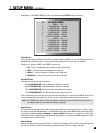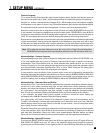
50
7. SETUP MENU continued …
7.4.4 SPEAKER LEVEL CALIBRATION
Speaker Level Calibration allows you to match the relative output level of each speaker at the listening
position, using internal test noises.
Note: The FRONTS, CENTER, SURROUNDS, REARS, SUB, and BALANCE buttons on the Front Panel and
Remote Control do not
affect settings in this menu – they allow ‘on-the-fly’ adjustment for
individual program material and Modes according to personal preference (sections 5.6 and 5.7).
* Item k. is displayed only when ‘a. SAME AS CINEMA CONFIG’ is set to ‘No’ in menu 2b.
Test Sequence:
Test noise can be set to travel from speaker to speaker manually using buttons, or automatically in two
second intervals by setting TEST SEQUENCE to ‘Auto’ using the buttons and then pressing SELECT.
Note: If the previously selected Source is Anlg-Dir, the AVM 30 switches to FM • AM, which is always
Anlg-DSP, for the duration of the test noise. (‘Anlg-Dir’ bypasses the test noise generator.)
We strongly recommend the use of an SPL meter. The proper meter setting is ‘C-weighted’, but ‘Flat’ can also
be used. Do not use ‘A-’ or ‘B-weighting’. Set the meter to read ‘Slow’ or ‘RMS’ if available. Point the meter
upwards, holding it at the listening position an arm’s length away from your body to prevent reflections.
Noise Reference Level:
This is the ‘master volume’ for the test noises, and allows you reduce how much adjustment each channel
will need based on how much output the Left Front channel has. The setting depends on the sensitivity of
your amplifier(s) and speakers. Using the buttons, adjust NOISE REF LEVEL so the SPL meter reads 75 dB.
Level Calibration:
Balances speaker levels to one another. Since this setup calibrates all speaker levels for your listening area,
use the Remote Control and sit in the primary listening area when calibrating speaker levels. Any speaker
set to ‘None’ in the Speaker Configuration menu will be skipped (see section 7.4.2). Once you have set the
reference level, adjust the level of each speaker using the buttons so the SPL meter reads 75 dB. As a
matter of personal preference, you can set the subwoofer level by ear if more bass is desired.
If Subwoofer is set to ‘Super’ in menu 2a. or 2b., do not rely on an SPL meter to set subwoofer level, because
Speaker Level Calibration cannot take into account the added bass the subwoofer receives from speakers
set to ‘Large’ which results in more bass during playback than the calibrated level. Therefore, if using
‘Super’, set subwoofer level by ear while playing various types of source material.
4. SPEAKER LVL CALIBRATION
a. TEST SEQUENCE: Manual
b. NOISE REF LEVEL: +0.0 dB
c. LEFT FRONT: +0.0 dB
d. CENTER: +0.0 dB
e. RIGHT FRONT: +0.0 dB
f. RIGHT SURROUND: +0.0 dB
g. RIGHT REAR: +0.0 dB
h. LEFT REAR : +0.0 dB
i. LEFT SURROUND: +0.0 dB
j. CINEMA CONFG SUB : +0.0 dB
k. MUSIC CONFG SUB: +0.0 dB
*


















